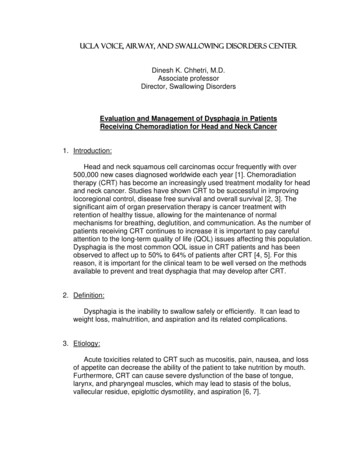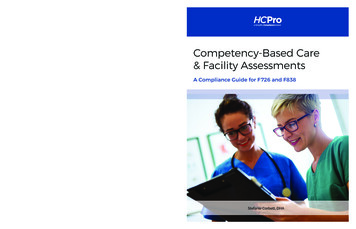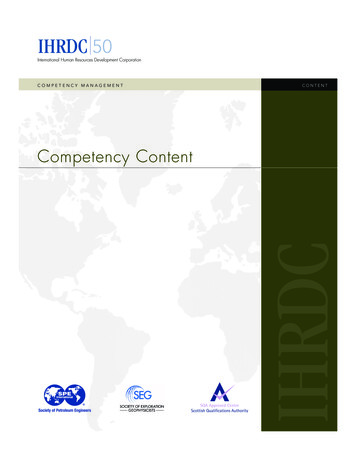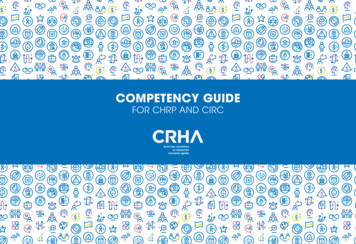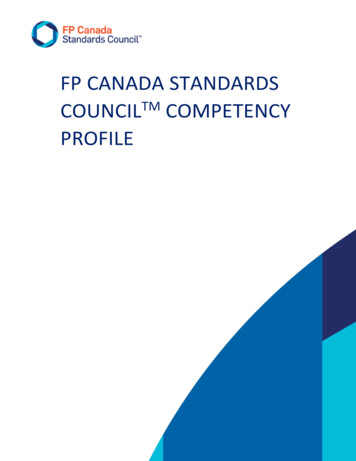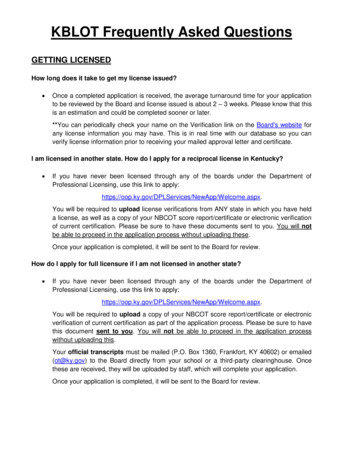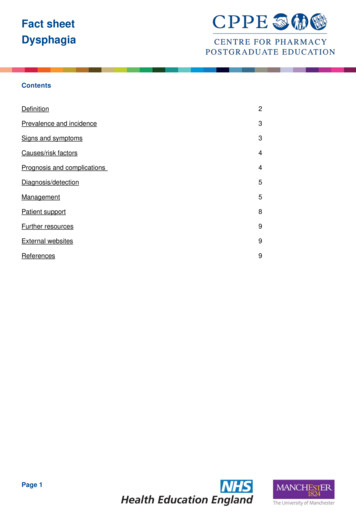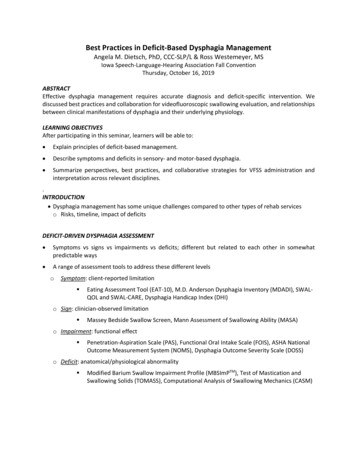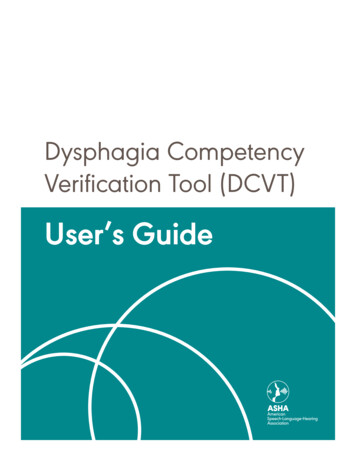
Transcription
Dysphagia CompetencyVerification Tool (DCVT)User’s Guide
Contents Introduction Prerequisites for Utilizing the DCVT Role of Preceptor Competency Sections Clinical Swallow Assessment and Dysphagia Treatment Videofluoroscopic Swallow Study (VFSS) Competency Fiberoptic Endoscopic Evaluation of Swallow with and without Sensory Testing (FEES/ST) Competency High-Resolution Manometry (HRM) Competency Continued Competency Review Specialization and Professional Development Age-Specific Competencies Special Populations and Facility-Specific Competencies Rating Levels of the DCVT Implementation of the DCVT Works ConsultedIntroductionClinicians can use the Dysphagia Competency Verification Tool (DCVT) to systematically assess clinicalcompetence for the provision of dysphagia services. This tool was developed by the Special Interest Groupon Swallowing and Swallowing Disorders (Dysphagia) (SIG13) and by the American Board of Swallowing andSwallowing Disorders (AB-SSD) Joint Committee on Dysphagia Competencies in response to affiliates’ requestfor guidance and guidelines for establishing and measuring clinical competence in the areas of (a) feedingand swallowing and (b) swallowing disorders. This tool is intended to be a resource for clinicians to use forself-assessment and for employers, supervisors, or preceptors to use as a tool for evaluating and documentingdysphagia knowledge and skill competencies.This tool is consensus-based and provided as a resource for members of the American Speech Language-Hearing Association (ASHA). Information included in this tooldoes not represent official ASHA policy. Portions of this tool are reprinted with permission from the American Board of Swallowing and Swallowing Disorders (ABSSD).
Dysphagia assessment and management now represents 39% of the caseload of responding speech-languagepathologists (SLPs) in health care settings who treat adults and 16% of the caseload of responding pediatricSLPs, according to the ASHA 2017 Health Care Survey.ASHA anticipates that the demand for dysphagia services will continue to grow as advances in medical careextend life at both ends of the age spectrum. Many settings require documented competencies for privileging ofservices provided or procedures performed.The Joint Commission (n.d.) states the following:The competency assessment looks at whether the clinical staff has the skills, knowledge, and abilities toperform the assigned job duties. Competency must be assessed by staff who understands the skills andknowledge required by the job responsibilities. Beyond the documented initial assessment to be finalizedupon the completion of the staff’s orientation, competency should be assessed on an on-going basis withdocumentation of such at least once every two years. (The Joint Commission, n.d., para 1)This document is a guide to assist the user in maximizing the utility of the DCVT. It describes the sections of theDCVT and the prerequisites for clinical advancement. The tool and guide will be available on the ASHA websiteand are openly sourced for clinical and facility use.The DCVT is intended to be a fluid document and will be reviewed and updated annually as evidence-basedpractice continues to evolve.Prerequisites for Utilizing the DCVTClinicians can utilize the DCVT provided that they meet the following prerequisites: Graduation from an accredited speech-language pathology program Knowledge of typical anatomy and physiology, including neuroanatomy and physiology, pertaining to theswallowing mechanism and related systems across the age continuum Knowledge of relevant risk factors and clinical indicators of dysphagia across the age continuumIndividual facilities may choose to assess and/or document knowledge via written test, discussion withpreceptor, and/or application of knowledge in supervised practice.Role of PreceptorThe preceptor is a practicing clinician with the desired skills and knowledge designated to give personalinstruction, training, and supervision to the clinician-in-training. When possible, the preceptor should beavailable on site to directly observe the skills being assessed.When a preceptor is unavailable, this tool can be utilized as a self-assessment tool to highlight areas in need ofdevelopment. Clinicians can then seek support from their local and ASHA community for professional growth.This tool is consensus-based and provided as a resource for members of the American Speech Language-Hearing Association (ASHA). Information included in this tooldoes not represent official ASHA policy. Portions of this tool are reprinted with permission from the American Board of Swallowing and Swallowing Disorders (ABSSD).
Competency SectionsClinical Swallow Assessment and Dysphagia Treatment — This section describes the core competencies of the clinicianevaluating and treating a patient with dysphagia. These are the clinical skills necessary to assess swallowing function in aclinical setting and to provide the appropriate intervention based on the patient’s/client’s age and disorder. The cliniciancan indicate specific age groups of interest based on the setting and job requirements. The clinician can modify the toolto reflect special population needs (i.e., clients with developmental disabilities, patients with head and neck cancer) orsetting-specific needs (i.e., school, skilled nursing facility). Prerequisites for this competency are the previously referencedknowledge documents.Additional sections are specific to instrumental examinations. In order to acquire the necessary skills, clinicians may benefitfrom topic-specific continuing education, observation, and mentored learning as prerequisites to clinical competency inthe performance of procedures.Videofluoroscopic Swallow Study (VFSS) Competency — This section describes the clinical skills necessary to perform andinterpret the VFSS. The clinician can indicate specific age groups of interest based on the setting and job requirements. Theclinician can modify the tool to reflect special population needs and setting-specific skills. Prerequisites for this competencyare the skills and knowledge documented in the Dysphagia Clinical Competency section of this document as well as thepreviously referenced knowledge documents.Fiberoptic Endoscopic Evaluation of Swallowing with and without Sensory Testing (FEES/ST) Competency — This sectiondescribes the clinical skills necessary to perform and interpret the FEES/ST. The clinician can indicate specific age groupsof interest based on the setting and job requirements. The clinician can modify the tool to reflect special population needsand setting-specific skills. Prerequisites for this competency are the skills and knowledge documented in the DysphagiaClinical Competency section of this document as well as the previously referenced knowledge documents.High-Resolution Manometry (HRM) Competency — This section describes the clinical skills necessary to perform andinterpret the HRM. The clinician can indicate specific age groups of interest based on the setting and job requirements. Thetool can be modified to reflect special population needs and setting-specific skills. Prerequisites for this competency are theskills and knowledge documented in two previous sections of this document (the Dysphagia Clinical Competency sectionand the FEES/ST Competency section) as well as the previously referenced knowledge documents.Continued Competency Review — This section is an annual or biennial review of previously documented skills andprivileges. The supervisor reviews three main knowledge areas—(a) the frequency of skill utilization (i.e., number ofprocedures that the clinician performed or treatment sessions that the clinician provided); (b) the number of accuracyand safety concerns that the clinician documented; and/or (c) the clinician’s ability to successfully function as a preceptor.These three areas then provide the basis for recommendations regarding clinical advancement or modification.Specialization and Professional Development — This section contains a list of knowledge, skills, and experiences thatreflect advanced competencies and professional development. The clinician can use documentation of education andmentorship, leadership roles, and research or scholarly activities in the area of feeding and swallowing development anddisorders as a clinical ladder within a facility (e.g., advancement to preceptor) or as a method of tracking professionalactivities for board specialization. This list is not all inclusive, nor are all items required to reflect specialization. The contentin this section is reprinted with permission from the American Board of Swallowing and Swallowing Disorders.This tool is consensus-based and provided as a resource for members of the American Speech Language-Hearing Association (ASHA). Information included in this tooldoes not represent official ASHA policy. Portions of this tool are reprinted with permission from the American Board of Swallowing and Swallowing Disorders (ABSSD).
Age-Specific CompetenciesAge-specific competencies are skills specific to defined age groups. Clinicians must know the principles ofgrowth and development over the life span, must be able to assess clinical data relative to patient age, andmust be able to interpret the information needed to identify patient needs relative to age-specific needs.Special Populations and Facility-Specific CompetenciesDetails about special populations and facility-specific competencies can be added to the tool to meet additionaland/or unique needs of individual facilities beyond the core competencies of the DCVT.Rating Levels of the DCVTThere are three main rating levels within the DCVT. These levels are defined below.1. In Training — Identifies that the clinician’s knowledge or skill is still in development and that continuedsupervision by a preceptor is required.2. Competent — Identifies that the clinician (a) has mastered the required basic knowledge and skills and (b)no longer requires supervision by the preceptor. Clinicians can continue to grow and develop beyond therating level of “competent” through pursuit of advanced training.3. Self-assessment — Assessing one’s own knowledge and skills encourages the clinician-in-training to reflecton strengths and areas of growth in order to foster discussion and direct continued learning.Implementation of the DCVTClinicians-in-training can follow these eight steps in order to implement the DCVT in their clinical setting:1. Modify the DCVT to meet specific needs of the facility and population to be served.2. Identify age groups to be managed within job specifications.3. Identify a preceptor with documented knowledge and skills.4. Perform a self-assessment to determine one’s self-perception of current skills and knowledge base.5. Identify areas of opportunity for skill development and provide additional training/resources as indicated.6. Perform procedure(s) with supervision from preceptor until the clinician-in-training demonstrates theexpected standard of care and skills needed to independently perform the procedure(s) with each agegroup requested.7. Perform annual competency review.8. Utilize specialization for clinical advancement.This tool is consensus-based and provided as a resource for members of the American Speech Language-Hearing Association (ASHA). Information included in this tooldoes not represent official ASHA policy. Portions of this tool are reprinted with permission from the American Board of Swallowing and Swallowing Disorders (ABSSD).
Works ConsultedAmerican Board of Swallowing and Swallowing Disorders. (n.d.) Application for Board Certification. Retrieved org/resource/resmgr/application/appendix a-d.pdfACR: American College of Radiology. (n.d.). Clinical resources—Radiology safety. Retrieved afetyAmerican Speech-Language-Hearing Association. (n.d.-a). Adult Dysphagia (Practice Portal). Retrieved Topics/Adult-Dysphagia/American Speech-Language-Hearing Association. (n.d.-b). ASHA 2017 Health Care Survey. Retrieved hcareSurvey/American Speech-Language-Hearing Association. (n.d.-c). Cleft Lip and Palate (Practice Portal). Retrieved Topics/Cleft-Lip-and-Palate/American Speech-Language-Hearing Association. (n.d.-d). Dementia (Practice Portal). Retrieved Topics/Dementia/American Speech-Language-Hearing Association. (n.d.-e). End-of-life issues in speech-language pathology. Retrieved erican Speech-Language-Hearing Association. (n.d.-f). Head and Neck Cancer (Practice Portal). Retrieved Topics/Head-and-Neck-Cancer/American Speech-Language-Hearing Association. (n.d.-g). Pediatric Dysphagia (Practice Portal). Retrieved Topics/Pediatric-Dysphagia/American Speech-Language-Hearing Association. (n.d.-h). Pediatric Traumatic Brain Injury (Practice Portal). Retrieved Topics/Pediatric-Traumatic-Brain-Injury/American Speech-Language-Hearing Association. (n.d.-i). Pediatric Traumatic Brain Injury—Assessment (Practice Portal).Retrieved from d 8589942939§ion AssessmentAmerican Speech-Language-Hearing Association. (n.d.-j). Tracheostomy and ventilator dependence. Retrieved /American Speech-Language-Hearing Association. (n.d.-k). Traumatic Brain Injury in Adults (Practice Portal). Retrieved Topics/Traumatic-Brain-Injury-in-Adults/CARF International—Commission on Accreditation of Rehabilitation Facilities. (2018). Accreditation—Quality standards.Retrieved from /The Joint Commission. (n.d.). Are competency assessments and performance evaluations the same or two differentrequirements? Retrieved from https://www.jointcommission.org/standards informationThis tool is consensus-based and provided as a resource for members of the American Speech Language-Hearing Association (ASHA). Information included in this tooldoes not represent official ASHA policy. Portions of this tool are reprinted with permission from the American Board of Swallowing and Swallowing Disorders (ABSSD).
Privilege: Clinical Swallow Assessment and Dysphagia TreatmentCPT: 92610, 92526Please see /SLPCPT/ for updated coding guidance.add your logoApplicant name:Date training initiated: Date competency attained:Preceptor name(s):Age group: Premature infants ( 38 weeks gestational age)Toddler (1–3)Key: SA Self-AssessmentChild (3–12)Neonate (0–30 days)Adolescent (13–18)PA Preceptor AssessmentInfant (1 mo–1year)Adult (18–65)T TrainingGeriatric (65 )C CompetentInstructions: Applicant will perform procedure with supervision from preceptor until the applicant demonstrates the expectedstandard of care and skills needed to independently perform the procedure with each age group requested.SA:BaselineratingPA: Datecompetency demonstratedGeneral SkillsSARatingPARatingDateDescribes relevant research on normal swallowingExplains strengths and limitations of clinical examination, including ability to detect aspiration and determine treatment strategies for pharyngeal swallowing disordersDescribes the etiology contributing to feeding and/or swallowing disordersIdentifies cognitive, communication, behavioral, and psychological factors contributing to feeding and/or swallowing statusDescribes the potential effects of common medications on swallowingDescribes the interrelationships of the oral, pharyngeal, and esophageal phases of swallowingDescribes cross-system relationships that influence feeding and/or swallowing (e.g., respiratory, gastrointestinal, neurological)Identifies signs and symptoms of feeding and/or swallowing disorders143401Describes nutritional intake methods (oral and non-oral) and the problems associated with each that may contribute todysphagia or be exacerbated by dysphagiaThis tool is consensus-based and provided as a resource for members of the American Speech Language-Hearing Association (ASHA). Information included in this tool does not represent officialASHA policy. Portions of this tool are reprinted with permission from the American Board of Swallowing and Swallowing Disorders (ABSSD).
General aborates with relevant team members regarding patient careDescribes and integrates evidence-based practice into patient assessment and careRecognizes medical contraindications of proceeding with direct assessment, signs of patient distress, and necessary responseDescribes differences between screening and assessmentDescribes indications and contraindications for instrumental swallow study referralDirect Patient CareObtains comprehensive medical and dysphagia history, including nature and duration of signs and symptoms, prior dysphagiaevaluation or treatment, response to treatment, and cultural and/or linguistic factors that may influence the patient’spreferences and attitudes toward feeding and/or swallowingDetermines baseline and current nutritional intake (e.g., positioning, feeding dependency, environment, diet modification, compensations)Identifies when swallowing assessment and intervention is appropriateConducts an oral, pharyngeal, laryngeal, cranial nerve, and respiratory function examination as it relates to functional assessment of feeding and/or swallowingIdentifies abnormal/atypical structure and functionAssembles the appropriate assessment materials (e.g., nipples, bottles, utensils, cups, foods/liquids) as per facility-specificprotocolIdentifies significant signs, symptoms, medical conditions, and medications pertinent to dysphagia during clinical assessmentRecognizes clinical signs and symptoms of airway compromiseTests interventions, including but not limited to postural changes, behavioral changes, maneuvers,bolus modifications (e.g.,texture, volume), delivery method (e.g., spoon, cup, bottle, nipple type), and sensory enhancement techniques to improve safetyand efficiency of the swallow and trials, as appropriateRefers for appropriate diagnostic tests, including instrumental swallow assessment, and consultations when indicated143401Provides recommendations regarding delivery of nutrition and hydration (oral, non-oral, or combination of the two)This tool is consensus-based and provided as a resource for members of the American Speech Language-Hearing Association (ASHA). Information included in this tool does not represent officialASHA policy. Portions of this tool are reprinted with permission from the American Board of Swallowing and Swallowing Disorders (ABSSD).
Direct Patient CareSARatingPARatingDateProvides recommendations regarding specific oral intake modifications (e.g., volume, viscosity, texture, etc.)Provides recommendations regarding compensatory and feeding precautions (e.g., strategies, positioning, assistance, supervision, etc.)Provides recommendations regarding rehabilitation treatment targeting physiologic deficits identified on assessment, utilizingevidence-based techniques when availableIntegrates and adapts plan of care to include patient’s cultural and personal preferencesProvides a prognostic statementEducates the patient and family/caregiver to the findings and recommendations, including options and relative risks/benefitsEducates the staff (e.g., physicians, nurses/CNAs, care planning team, teachers, aides) as to findings and recommendations,and advocates for swallowing-related servicesGenerates documentation that is clear, concise, complete, and interpretive (e.g., assessment performed/findings, impression,severity, prognosis, recommendations, and goals)Identifies necessary follow-up care, including frequency of treatment, monitoring, and/or reevaluationProvides ongoing assessment and revises treatment goals as appropriate, based on patient responseDevelops and implements treatment plan targeting physiologic deficits identified on assessmentDocuments response to treatment using objective and measurable data collection systemsAdjusts treatment plan, content and delivery to the level of the person being educated, counseled, or trainedIdentifies discharge/dismissal criteriaSeeks assistance and collaboration as needed in the assessment and care of persons with dysphagiaPopulation- and Setting-Specific Skills (e.g., Trach/Vent, HNC, NICU, etc.)Describes best practices for providing interventions when complicated and/or special medical conditions are seen which mayhave an impact on an individual’s feeding and swallowing (population/setting specific skills may beadded below)Clinician Name/Initials:Primary Preceptor/Initials:143401Date Privileging Process Initiated:This tool is consensus-based and provided as a resource for members of the American Speech Language-Hearing Association (ASHA). Information included in this tool does not represent officialASHA policy. Portions of this tool are reprinted with permission from the American Board of Swallowing and Swallowing Disorders (ABSSD).
NOTES143401This tool is consensus-based and provided as a resource for members of the American Speech Language-Hearing Association (ASHA). Information included in this tool does not represent officialASHA policy. Portions of this tool are reprinted with permission from the American Board of Swallowing and Swallowing Disorders (ABSSD).
Privilege: Videofluoroscopic Swallow Study (VFSS)CPT: 92611Please see /SLPCPT/ for updated coding guidance.add your logoApplicant name:Date training initiated: Date competency attained:Preceptor name(s):Prerequisites: Privileges in Clinical Swallow Assessment and Dysphagia TreatmentAge group: Premature infants ( 38 weeks gestational age)Toddler (1–3)Child (3–12)Key: SA Self-AssessmentNeonate (0–30 days)Adolescent (13–18)PA Preceptor AssessmentInfant (1 mo–1year)Adult (18–65)T TrainingGeriatric (65 )C CompetentInstructions: Applicant will perform procedure with supervision from preceptor until the applicant demonstrates the expected standard of care and skills needed to independently perform the procedure with each age group requested.SA: BaselineratingPA: DatecompetencydemonstratedProcedure-Related SkillsSA RatingPA RatingDateVerbalizes the indications, contraindications, risks, benefits, and precautions (e.g., radiation exposure) for videofluoroscopic examinationIdentifies patients who are and are not appropriate for VFSSDescribes the elements of a comprehensive exam and facility-specific protocolVerbalizes roles of the personnel involved in studyDemonstrates appropriate setup for VFSSEducates the patient and family/caregiver regarding the purpose and process of examination, as appropriateCommunicates the reason for the exam to the radiologist or other medical staffIdentifies radiographic anatomical landmarks, including typical and atypical anatomyFollows a standardized protocol for bolus presentationEvaluates the integrity of airway protection before, during, and after swallowingObtains lateral and anterior–posterior views, as able143401Implements postures, maneuvers, sensory enhancements, and bolus modifications, as appropriate, based on radiographic findingsand the individual’s overall functioning levelEvaluates the effectiveness of postures, maneuvers, bolus modifications, and sensory enhancement techniques, as appropriate,based on radiographic findings and the individual’s overall functioning levelThis tool is consensus-based and provided as a resource for members of the American Speech Language-Hearing Association (ASHA). Information included in this tool does not represent officialASHA policy. Portions of this tool are reprinted with permission from the American Board of Swallowing and Swallowing Disorders (ABSSD).
Procedure-Related SkillsSA RatingPA RatingDateEvaluates the individual’s tolerance of and ability to perform and repeat appropriate therapeutic interventions as appropriate,based on radiographic findings and the individual’s overall functioning levelConducts the examination in a timely manner to minimize radiation exposureMonitors possible adverse reactions to the examination (e.g., changes in breathing pattern, level of alertness, agitation, pallor, etc.)Reviews the recorded VFSSIdentifies and documents the physiologic components of swallowingIdentifies and documents the impact of anatomic and physiologic impairment (i.e., location and severity of residue, laryngeal penetration, presence, timing, and approximate percentage of aspiration)Documents the patient’s apparent awareness of and response to residue, laryngeal penetration, and/or aspiration (i.e., cough,throat clear, second swallow)Documents compensatory postures, maneuvers, delivery methods, sensory enhancements, and bolus modifications attempted—and the effectiveness of eachDocuments the individual’s tolerance of and response to study (e.g., ability to follow directions, fatigue factor, and ability to repeattherapeutic interventions)If esophageal screening is completed, describes any suspected anatomic and/or physiologic abnormalities of the esophaguswhich might impact the pharyngeal swallow, deferring to radiology for diagnostic statementsFormulates treatment and management strategies based on patient performance and integrates patient, family, and caregiverinput into treatment planInterprets and documents findings in a written report, including diagnosis, severity, prognosis, recommendations, and goalsDiscusses the results and consults with appropriate medical personnel in a collaborative model, as possibleRefers for additional instrumental swallowing examinations (e.g., FEES, HRM), as appropriate, based on findingsIncorporates radiation safety techniques (e.g., time, distance, shielding) for all individuals within the radiology suite during theexaminationInforms appropriate personnel (e.g., radiation safety officer) of any special circumstances that might impact the clinician’s ability toparticipate in the videofluoroscopic swallowing exam and take appropriate action to ensure personal safetyPopulation- and Setting-Specific Skills (e.g., Trach/Vent, HNC, NICU, etc.)Describes best practices for providing interventions when complicated and/or special medical conditions are seen which may havean impact on an individual’s feeding and swallowing (population/setting specific skills may be added below)Clinician Name/Initials:Primary Preceptor/Initials:143401Date Privileging Process Initiated:This tool is consensus-based and provided as a resource for members of the American Speech Language-Hearing Association (ASHA). Information included in this tool does not represent officialASHA policy. Portions of this tool are reprinted with permission from the American Board of Swallowing and Swallowing Disorders (ABSSD).
NOTES143401This tool is consensus-based and provided as a resource for members of the American Speech Language-Hearing Association (ASHA). Information included in this tool does not represent officialASHA policy. Portions of this tool are reprinted with permission from the American Board of Swallowing and Swallowing Disorders (ABSSD).
Privilege: Fiberoptic Endoscopic Evaluation of Swallowing (FEES)CPT: 92612Please see /SLPCPT/ for updated coding guidance.add your logoApplicant name:Date training initiated: Date competency attained:Preceptor name(s):Key: SA Self-AssessmentPA Preceptor AssessmentT TrainingC CompetentInstructions: Applicant will perform procedure with supervision from preceptor until the applicant demonstrates the expectedstandard of care and skills needed to independently perform the procedure with each age group requested.SA:BaselineratingPA: Datecompetency demonstratedProcedure-Related gnizes anatomical landmarks as viewed endoscopicallyIdentifies the indications and contraindications for FEES, including who is and is not a candidate for the studyIdentifies and explains the risks, benefits, and precautions related to FEESIdentifies the elements of a comprehensive FEESAdapts evaluation, as appropriate, for patient’s medical diagnosis or response (e.g., BOLT, esophago, cardiac, etc.)Operates, maintains, and disinfects the equipment needed for an endoscopic examinationApplies topical anesthetic when clinically appropriate and when permitted by the licensing regulations of individual statesInserts and manipulates the endoscope that obtains desired view in a manner that causes minimal discomfort and preventsunpleasant complicationsManipulates the endoscope within the hypopharynx to obtain the desired viewDirects the patient through appropriate tasks and maneuvers as required for a complete and comprehensive examinationProcedure-Related SkillsDemonstrates knowledge of medical contraindications, impending signs of patient distress, and appropriate actions to take ifcomplications ariseDetects and interprets abnormal findings in terms of the underlying anatomy and pathophysiologyAssesses vocal fold mobility and laryngeal closure for phonation, breath holding, and coughAssesses secretion management, quantity and location of pharyngeal residue, pharyngeal constriction/contraction symmetry,and swallow initiation143401Presents various bolus consistencies, dyed green for contrast, based on clinical assessmentThis tool is consensus-based and pr
Dysphagia assessment and management now represents 39% of the caseload of responding speech-language pathologists (SLPs) in health care settings who treat adults and 16% of the caseload of responding pediatric . Graduation from an accredited speech-language pathology program Knowledge of typical anatomy and physiology, including .
